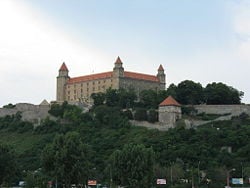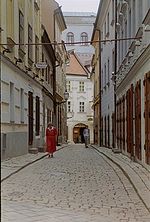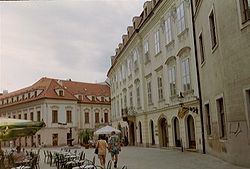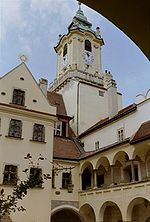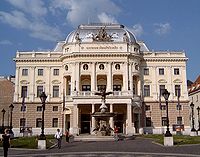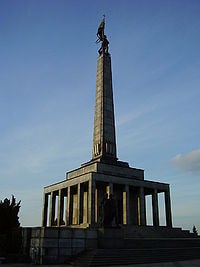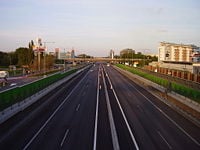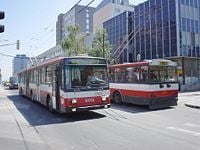Difference between revisions of "Bratislava" - New World Encyclopedia
| Line 110: | Line 110: | ||
* Around the time of the birth of [[Christ]] the Romans discovered the strategic importance of the site of today’s Bratislava. They did not settle the area permanently; instead they built military camps to protect local trade. One of such camps, called Gerulata, was situated on the site of the Bratislava district of Rusovce and represented part of the defense system Limes Romanus, which separated the Roman world from the [[Barbarian|barbaric]] tribes. The Romans also established the city's reputation as one of vintners and viticulturists. Part of the mission of the Roman conquests was namely to introduce vines and wine-making to all inhabited areas. This is how wine-growing eventually spread to other countries as well, such as France, Spain, and Germany. | * Around the time of the birth of [[Christ]] the Romans discovered the strategic importance of the site of today’s Bratislava. They did not settle the area permanently; instead they built military camps to protect local trade. One of such camps, called Gerulata, was situated on the site of the Bratislava district of Rusovce and represented part of the defense system Limes Romanus, which separated the Roman world from the [[Barbarian|barbaric]] tribes. The Romans also established the city's reputation as one of vintners and viticulturists. Part of the mission of the Roman conquests was namely to introduce vines and wine-making to all inhabited areas. This is how wine-growing eventually spread to other countries as well, such as France, Spain, and Germany. | ||
* '''6th century - 8th century''': arrival of [[Slavs]] (500 C.E.- today) and Eurasian Avars (560s - 8th century) | * '''6th century - 8th century''': arrival of [[Slavs]] (500 C.E.- today) and Eurasian Avars (560s - 8th century) | ||
| − | : | + | |
| − | + | ===Samo's Empire: 623-658=== | |
| + | Samo sa usadil natrvalo na Slovensku a zriadil s našimi slovanskými predkami prvú nadkmeňovú spoločenskú organizáciu vojensko - obrannej povahy, ktorú postupne rozvinul do vtedajšej formy štátneho útvaru. Tento štát vošiel do dejín ako Samova ríša, alebo Samovo kráľovstvo. Centrom toho štátneho útvaru bolo územie okolo Bratislavy a Nitry. | ||
| + | Rok 659, kráľ Samo, ktorí vládol 35 rokov umiera. Samova ríša bola kmeňovým zväzom, spojeným silnou osobnosťou vládcu, a po jeho smrti sa rozpadla. Slovenský Slovania už neboli schopní odolávať avarskej presile, preto upadli znova pod nadvládu Avarov. | ||
| + | http://referaty.atlas.sk/vseobecne-humanitne/dejepis/28729/slovania-samova-risa-velka-morava | ||
| + | |||
| + | Avaři a jejich spojenci (Slované, Gepidové, Bulhaři, některé kmeny Hunů.) byli pod vedením Bajana strašlivou hrozbou pro všechny sousedy, ať jde o Byzanc nebo Porýní. Bajanovi nástupci však nebyli tak obratní a spojenecká loupežná tažení přinášela stále menší efekt. První porážku schytali roku 601 a neúspěšných bylo i pět dalších výprav. Avarští spojenci z toho byli právem stále rozmrzelejší; skutečný zlom nastal v roce 626, kdy společné několikaměsíční obléhání Konstantinopole skončilo fiaskem a spojenecký svaz, který Bajan vybudoval, se rozpadl. Rýnský kupec Sámo (Samuel, na Franka podivné, až židovsky znějící jméno, že?) se na scéně historie objevuje někdy v této době. Geniálně využil situaci k vybudování vlastní kariéry. Poprvé prý ke Slovanům přijel snad roku 623 | ||
| + | Kupec, to znamenalo více než bohatý člověk, kupec operující v té době v teritoriu střední a středovýchodní Evropy měl početnou ozbrojenou družinu (kolem stovky lidí), několik vozů zboží, zajištěné obchodní stanice. Jinak by nepřežil. Samozřejmě, že nemůže být ani slovo o utlačovaných Slovanech, natož o Sámově altruismu a chuti pomoci slabším. Sáma jistě rozhořčovala obchodní nejistota, nebezpečí šířené Avary a Slovany všude kolem, a nejspíš si i uvědomoval ohromný potenciál slovanského nedotčeného trhu. Viděl schopné, ale mizerně vyzbrojené vojsko s rozhádanými a nesvornými knížaty v čele. Pokud uvažoval v politické rovině, jeho cílem bylo využít rozpadu obávaného loupežného uskupení, snad jej podle možností i trochu urychlit a prohloubit, a ekonomicky ovládnout jím zabíraný prostor. To ostatní už známe z dějepisu - vyzbrojil Slovany a vedl je do války proti bývalému spojenci, nechal se slovanskými náčelníky zvolit za "krále" a pokusil se vybudovat slovanskou říši po vzoru říše francké (629), o dva roky později se odmítl podrobit Dagobertovi a následně porazil jeho vojsko. Byl úspěšným, obratným politikem, šikovným obchodníkem a mužem vysokého ega. | ||
| + | ámo spoluzpůsobil pacifikaci slovanských kmenů. Naši prapředci zanechali loupežných výprav, soustředili se na zemědělství a hleděli si, aby se od sousedů i starousedlíků něco přiučili | ||
| + | http://www.skola.iol.cz/prilohy/202_7_0.htm | ||
| + | |||
| + | ===Great Moravian Empire=== | ||
* late 8th century]] – 833: part of the Principality of Nitra | * late 8th century]] – 833: part of the Principality of Nitra | ||
* 833 – 907: part of [[Great Moravia]]. During the migration of nations, Slavs settled in the area of present day Bratislava. Led by the Frankish merchant Samo, they founded the Empire of King Samo, which was the first known organized community of Slavs that served as protection against the raids of nomadic Avars. After Samo’s death, the Empire dissolved into principalities, whose subsequent merger gave rise to the Great Moravian Empire. The Slav realm culminated during the reign of the most distinguished lord, Svätopluk. Salzburg chronicles, dated from 907, provide the first written record of Bratislava Castle, and this period coincides with the start of the gradual demise of the Great Moravian Empire. The chronicles mention a battle between Hungarian and Bavarian troops that took place near the castle. The Hungarians won and occupied the eastern part of Great Moravia. | * 833 – 907: part of [[Great Moravia]]. During the migration of nations, Slavs settled in the area of present day Bratislava. Led by the Frankish merchant Samo, they founded the Empire of King Samo, which was the first known organized community of Slavs that served as protection against the raids of nomadic Avars. After Samo’s death, the Empire dissolved into principalities, whose subsequent merger gave rise to the Great Moravian Empire. The Slav realm culminated during the reign of the most distinguished lord, Svätopluk. Salzburg chronicles, dated from 907, provide the first written record of Bratislava Castle, and this period coincides with the start of the gradual demise of the Great Moravian Empire. The chronicles mention a battle between Hungarian and Bavarian troops that took place near the castle. The Hungarians won and occupied the eastern part of Great Moravia. | ||
Revision as of 03:57, 7 March 2007
| Bratislava | |||
|---|---|---|---|

| |||
| Region (kraj) | Bratislava Region | ||
| District (okres) | Bratislava I-V | ||
| Location | coord}}{{#coordinates:48|08|41|N|17|06|46|E|type:city_scale:30000 | name=
}} | |
| Altitude | 126-514 m | ||
| Population | 446,819 (as of 2005) | ||
| Area | 367.59 km² | ||
| Time Zone • Summer DST |
CET: UTC+1 CEST: UTC+2 | ||
| Telephone prefix | +421-2 | ||
| Postal code | 8XXXX | ||
| Car registration plate | BA | ||
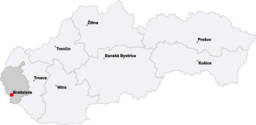
| |||
Bratislava (see below for other names) is the capital of Slovakia and the country's largest city, with a population of some 450,000. Bratislava is the political, cultural and economic center of Slovakia. It is the seat of the Slovak presidency, parliament and government as well as home to several universities, museums, theaters, galleries and other national economic, cultural and educational institutions. Most of Slovakia's large businesses and financial institutions have their headquarters in Bratislava. The city's past has been characterized by the strong influence of various peoples, including Slovaks, Germans, Hungarians, Czechs, Austrians and Jews. Bratislava still retains its cosmopolitan spirit. It hosts many festivals and trade shows and it is famous for its night life and leisure facilities. Bratislava leží na Dunaji v jihozápadní části Slovenska. Má přibližně 450 000 obyvatel. Město se dělí na 5 okresů a ty se dále člení na 17 městských částí. Historie Bratislavy Bratislava vznikla na místě, kde se v minulosti střetávaly nejdůležitější obchodní cesty. Bylo zde významné sídlo Keltů, od 6. století pak bylo město osídleno Slovany. Do roku 1918 byla Bratislava součástí Uherska, později Habsburské monarchie. Roku 1919 se stává hlavním městem Slovenské republiky. Po vzniku samostatné Slovenské republiky (1993) se město stalo také sídlem prezidenta a nejvyšších státních institucí. Bratislava – středisko kultury Bratislava je střediskem slovenského školství, vědy a kultury. Pravidelně se tu konají známé festivaly jako např. Bratislavské hudební slavnosti, Bratislavská lyra nebo výstava květů Flóra. Je zde více než 20 muzeí a 80 galerií. Do Opery jezdí každý den návštěvníci z Vídně.
Základní údaje o Bratislavě
Bratislava je známa ako mesto na Dunaji, križovatka európskych ciest, tradičné kultúrne a správne centrum, sem prichádzali, tu žili, pracovali a vytvárali hodnoty mnohé národy. Tu zanechali svoje kultúrne stopy Keltovia, Rímani, Germáni, starí Slovania. Od 13. storočia, keď získala veľké mestské privilégia sa na jej duchovnom profile podieľa celý rad význačných osobností slovenskej, nemeckej, maďarskej , ale i chorvátskej, bulharskej, českej, židovskej národnosti. Nezastupiteľný je podiel kresťanskej kultúry na duchovnom a kultúrnom obraze mesta, významný je však aj príspevok židovskej náboženskej obce. V nedávnom období, najmä v 2. polovici 20. storočia pestrú mozaiku kultúrneho obrazu mesta výrazne obohatili obyvatelia z blízkych i vzdialených regiónov Slovenska.
Bratislava is picturesquely situated on both banks of the Danube, at the base of the outlying spurs of the Lesser Carpathians, in a position of strategic importance near the Devín Gate (earlier called Hainburger Pforte or Porta Hungarica). The area includes a picturesque old town centre.
Bratislava bola aj mestom pestovania a prezentácie kultúry z ďalších európskych regiónov. Najvýraznejším príkladom je zanietenie predstaviteľov šľachtického rodu Erdody pre francúzsku kultúru. V salónoch Erdödyovského paláca v nároží ulíc Ventúrska a Panská sa takmer 150 rokov pestovala francúzska kultúra a jaj posolstvo sa z Bratislavy šírilo aj do tradičných stredoeurópskych kultúrnych centier. V prvej polovici 20. storočia logicky a kontinuálne na túto tradíciu nadviazala „Maison Francaise“, ktorá v tomto objekte pôsobila až do 50-tych rokov.
Bratislava si vyslúžila i ďalšie označenia a prívlastky ako komorné veľkomesto, mesto vzdelania, mesto hudby, mesto mieru a zaslúžene. Bohatá a pestrá štruktúra a vysoká kvalita kultúrneho a spoločenského života sa premietla na začiatku 20. storočia do široko rozvetvenej sústavy kultúrnych a spoločenských združení, exkluzívnych klubov i záujmových a profesných spolkov, ktoré ďalej rozvíjali kultúrny odkaz. Kontinuálny obraz kultúrneho, spoločenského a duchovného života mesta Bratislavy po dočasnom prerušení opäť získava svoje hlavné obrysy i silu a kvalitu bohatého obsahu.
Bratislava is one of the youngest capitals in Europe and few people know that during the time it was called Pressburg or Pozsony it was one of the most important cities in the Austro-Hungarian Empire. It was a mixing pot of various nations and nationalities who lived together in peace and harmony. There is a saying that a true ‘Pressburgian’ speaks four languages: Slovak, German, Hungarian and Mishmash. Even as recently as the 1980s you might hear how older Pressburgians in the street would say two words in German, two in Hungarian and two in Slovak all in the space of one sentence. That is what we mean by “mishmash”. Bratislava’s location on the banks of the River Danube and at the crossroads of ancient trading routes right at the heart of Europe predestined it to become a meeting point of various cultures. It was the home of the Celts, the Romans, and the Slavs ... The reign of Maria Theresa is regarded as a golden era in the city’s history. She was crowned Queen of Hungary in St. Martin’s cathedral in Pressburg, just like the 10 other kings and 8 royal partners over the course of 300 years when Pressburg was in fact the capital of the Kingdom of Hungary. The rich mix of cultures and nations not only left its mark in the language spoken here, but also in the customs, cuisine and lifestyle. Just like the Viennese, the people of Bratislava also enjoy promenading through the streets of the city centre, taking time out for a coffee in any of the many cafes. This part of the city is referred to as the Korzo and combines elegance with charm. Visitors say that the city has a relaxed Mediterranean type atmosphere. Bratislava is a seaside city without the sea. Nowadays Bratislava is experiencing a boom once more. Buildings are popping up, deals being made, people studying, and everything is on the move. Experts regard it as one of the most dynamically developing and most prospective regions in Europe. It welcomes tourists, business people, and investors, who are attracted to this blooming city and its lively atmosphere. There are many cities in Europe that can boast their own special unique charm, and Bratislava is definitely one of them.
Etymology
In March 1919 Bratislava was adopted as the official name. It is not known on what grounds. One theory is that the name was invented by US president Wilson, another that it might be a corruption of the old Slavic Braslava. However, we know for sure that a variant of this name was reconstructed by Pavel Jozef Šafárik (by mistake) from old names in the 1830s based on the name of the Bohemian ruler Bretislav I. It was used subsequently by members of the Slovak movement in the 1840s and occasionally also afterwards.
A more detailed list can be found in the History of Bratislava article.
| Bratislava's names most commonly used before 1920 | ||
|---|---|---|
| Preßburg | German (before the 19th century occasionally and since the German spelling reform of 1996 regularly spelled Pressburg) | |
| Prešporok | Slovak name; stems from the German one (one of the many variants was Pressporek in 1773) | |
| Prešpur(e)k or Presspur(e)k | Czech | |
| Pressburg(h) or Pressborough | English (Pressburg Street in southwestern London) | |
| Presburgo | Spanish | |
| Pressbourg later Presbourg | French (rue de Presbourg in Paris) | |
| Presburg | Dutch | |
| Pozsony | Hungarian (still in use by Hungarians today). Earlier variant Posony (1773) | |
| Posonium | Latin | |
| Požun | Croatian, Serbian, Bosnian | |
| Pozhoma | Romani | |
| Istropolis | Greek, meaning the Danube City | |
Geography
Bratislava lies on both banks of the River Danube and is the only capital in the world that borders two countries, Austria and Hungary, and is only an hour's drive from the border with the Czech Republic. The Little Carpathians (Malé Karpaty) massif of the Carpathian Mountains mountain range begins within its territory. The Austrian capital Vienna is only 50 km away. Two more rivers flow across the city — Morava, which forms its northwestern border, and the Little Danube.
Climate: The climate is mild, with frequent winds and marked variations between hot summers and cold, humid winters.
- annual average temperature: 9.9 °C
- annual sunshine hours: 1976.4 (5.4 hours/day)
- annual average rainfall: 527.4 mm (according to 1993 data)
Prehistory and Early Middle Ages
- Bratislava's position at the heart of Europe on the banks of the River Danube predestined it to becoming a crossroads and destination point for trade routes as well as a hub of various cultures. The first traces of a permanent settlement are associated with the late Stone Age.
- Neolithic Age: the first permanent settlement of the region begins with the Linear Pottery Culture.
- 400 B.C.E. - 50 B.C.E.: Celts were settled here. The real door to history, however, did not open until the arrival of the Boii Celtic tribe in the 2nd century B.C.E., as they established a strategic power and defense center here. In 125 B.C.E. they founded an oppidum (fortified town) with a coin mint. The most well-known coin is the gold Stater with the inscription Biatec. Just as Vienna, Budapest, Paris, and other major European cities, Bratislava stands on the foundations of a Celtic settlement.
- 100 C.E. - 500 C.E.: the border of the Roman Empire (Limes Romanus) runs across the center of today's city; Romans and Germanic tribes form settlements.
- Around the time of the birth of Christ the Romans discovered the strategic importance of the site of today’s Bratislava. They did not settle the area permanently; instead they built military camps to protect local trade. One of such camps, called Gerulata, was situated on the site of the Bratislava district of Rusovce and represented part of the defense system Limes Romanus, which separated the Roman world from the barbaric tribes. The Romans also established the city's reputation as one of vintners and viticulturists. Part of the mission of the Roman conquests was namely to introduce vines and wine-making to all inhabited areas. This is how wine-growing eventually spread to other countries as well, such as France, Spain, and Germany.
- 6th century - 8th century: arrival of Slavs (500 C.E.- today) and Eurasian Avars (560s - 8th century)
Samo's Empire: 623-658
Samo sa usadil natrvalo na Slovensku a zriadil s našimi slovanskými predkami prvú nadkmeňovú spoločenskú organizáciu vojensko - obrannej povahy, ktorú postupne rozvinul do vtedajšej formy štátneho útvaru. Tento štát vošiel do dejín ako Samova ríša, alebo Samovo kráľovstvo. Centrom toho štátneho útvaru bolo územie okolo Bratislavy a Nitry. Rok 659, kráľ Samo, ktorí vládol 35 rokov umiera. Samova ríša bola kmeňovým zväzom, spojeným silnou osobnosťou vládcu, a po jeho smrti sa rozpadla. Slovenský Slovania už neboli schopní odolávať avarskej presile, preto upadli znova pod nadvládu Avarov. http://referaty.atlas.sk/vseobecne-humanitne/dejepis/28729/slovania-samova-risa-velka-morava
Avaři a jejich spojenci (Slované, Gepidové, Bulhaři, některé kmeny Hunů.) byli pod vedením Bajana strašlivou hrozbou pro všechny sousedy, ať jde o Byzanc nebo Porýní. Bajanovi nástupci však nebyli tak obratní a spojenecká loupežná tažení přinášela stále menší efekt. První porážku schytali roku 601 a neúspěšných bylo i pět dalších výprav. Avarští spojenci z toho byli právem stále rozmrzelejší; skutečný zlom nastal v roce 626, kdy společné několikaměsíční obléhání Konstantinopole skončilo fiaskem a spojenecký svaz, který Bajan vybudoval, se rozpadl. Rýnský kupec Sámo (Samuel, na Franka podivné, až židovsky znějící jméno, že?) se na scéně historie objevuje někdy v této době. Geniálně využil situaci k vybudování vlastní kariéry. Poprvé prý ke Slovanům přijel snad roku 623 Kupec, to znamenalo více než bohatý člověk, kupec operující v té době v teritoriu střední a středovýchodní Evropy měl početnou ozbrojenou družinu (kolem stovky lidí), několik vozů zboží, zajištěné obchodní stanice. Jinak by nepřežil. Samozřejmě, že nemůže být ani slovo o utlačovaných Slovanech, natož o Sámově altruismu a chuti pomoci slabším. Sáma jistě rozhořčovala obchodní nejistota, nebezpečí šířené Avary a Slovany všude kolem, a nejspíš si i uvědomoval ohromný potenciál slovanského nedotčeného trhu. Viděl schopné, ale mizerně vyzbrojené vojsko s rozhádanými a nesvornými knížaty v čele. Pokud uvažoval v politické rovině, jeho cílem bylo využít rozpadu obávaného loupežného uskupení, snad jej podle možností i trochu urychlit a prohloubit, a ekonomicky ovládnout jím zabíraný prostor. To ostatní už známe z dějepisu - vyzbrojil Slovany a vedl je do války proti bývalému spojenci, nechal se slovanskými náčelníky zvolit za "krále" a pokusil se vybudovat slovanskou říši po vzoru říše francké (629), o dva roky později se odmítl podrobit Dagobertovi a následně porazil jeho vojsko. Byl úspěšným, obratným politikem, šikovným obchodníkem a mužem vysokého ega. ámo spoluzpůsobil pacifikaci slovanských kmenů. Naši prapředci zanechali loupežných výprav, soustředili se na zemědělství a hleděli si, aby se od sousedů i starousedlíků něco přiučili http://www.skola.iol.cz/prilohy/202_7_0.htm
Great Moravian Empire
- late 8th century]] – 833: part of the Principality of Nitra
- 833 – 907: part of Great Moravia. During the migration of nations, Slavs settled in the area of present day Bratislava. Led by the Frankish merchant Samo, they founded the Empire of King Samo, which was the first known organized community of Slavs that served as protection against the raids of nomadic Avars. After Samo’s death, the Empire dissolved into principalities, whose subsequent merger gave rise to the Great Moravian Empire. The Slav realm culminated during the reign of the most distinguished lord, Svätopluk. Salzburg chronicles, dated from 907, provide the first written record of Bratislava Castle, and this period coincides with the start of the gradual demise of the Great Moravian Empire. The chronicles mention a battle between Hungarian and Bavarian troops that took place near the castle. The Hungarians won and occupied the eastern part of Great Moravia.
Part of the Kingdom of Hungary (907-1918)
- From 2nd half of the 10th century to 1918: except short interruptions, part of the Kingdom of Hungary and the capital of the Bratislava county (Posonium Comitatus). The Kingdom of Hungary was formed under the rule of Stephan I (1001-1038), and the city was annexed to it. Toward the end of the 10th century, Bratislava was a key economic and administrative center of the kingdom’s frontier, which had a downside in the form of frequent onslaughts by foreign invaders. In 1042 the city was destroyed by German King Henry I. More plight followed between 1074 and 1077 with the battle for the Hungarian throne.
- In the 13th century Bratislava was afforded royal privileges. King Sigismund of Luxembourg, who ruled at the turn of the 14th and 15th centuries, reaffirmed the older donations and privileges granted to it by the Houses of Arpad and Anjou and extended new privileges, whereby the city was promoted to a major political and economic hub within the Kingdom of Hungary. Upon Sigismund's decree from 1405, Bratislava became to be referred to as a free royal city and thus assumed the status enjoyed only by the most distinguished cities of that time. In 1436 Bratislava was granted by King Sigismund a coat-of-arms deed with escutcheon rights, and as the only city in Europe it had this deed drawn up in two copies, both created by the painter Michal from the Vienna workshop.
Battle of Mohacs —> Capital of the Kingdom of Hungary
- The 16th century brought with it a turnaround in the history of the city when Hungarian King Louis II died after falling from his horse in the 1526 Battle of Mohacs with the Turks. In spite of resistance from a large part of the Hungarian nobility and a candidate for the thrown in the person of John Zapolya, Ferdinand Habsburg ascended to the thrown, and the Turks advanced swiftly into the heart of Slovakia. The Hungarian nobility fled the territory of Slovakia and abandoned local authorities. In 1530 the Ottoman Turks partly leveled Bratislava with cannon fire. However, the Battle of Mohacs fiasco paradoxically worked in favor of the city, as the Hungarian nobility and secular and clerical dignitaries looked to the north for refuge following the occupation of the Kingdom of Hungary capital Buda. In addition, it was conveniently close to Vienna, the seat of King Ferdinand. This unique location and relative safety predestined Bratislava to becoming the new capital of the Kingdom of Hungary in 1536. The small city of traders, craftsmen, and winemakers thus turned into the center of Slovakia as well as the lordship and the Church – it became the seat of the Parliament of the kingdom and the coronation city of Hungarian kings, the seat of the king, the archbishop and major institutions. Between 1536-1830 some 11 kings and queens were crowned at its St. Martin’s Cathedral.
- 1536-1784: capital of the Kingdom of Hungary, which until 1699 comprised present-day Slovakia and parts of present-day West Hungary. The Turks ruled Buda; the Kingdom of Hungary was part of the larger Austrian Habsburg Monarchy from 1526 to 1918. It was the coronation town of Hungarian Kings until 1830 and a meeting place of the Hungarian Diet until 1848.
Empress Maria Theresa and Slovak National Movement
In the 18th century Bratislava became not only the largest and most important city in Slovakia but also of the entire Kingdom of Hungary. This century saw the construction of splendid palaces for the Hungarian aristocracy as well as churches, monasteries, and other clerical buildings as the population tripled. The city pulsed with a thriving cultural and social life. The greatest boom came with the ascension on the throne by Empress Maria Theresa (1740-1780) and the start of the management of construction development by the Hungarian royal chamber, which managed the construction of government mandated buildings in particular. Major construction work was also carried out on the castle, which became the seat of the local royal governor and the center of social and political life.
Joseph II Turns Back Time
The government of Joseph II spelled decline for the city, which was quickly stripped off its privilege as the capital of the Kingdom of Hungary. In 1783 Joseph ordered the relocation of the governor’s council and other central authorities to Buda; and soon afterward he took the royal crown, housed at the Bratislava castle, to Vienna. These steps spurred a mass exodus of nobility from, and Bratislava once again turned into a mere provincial city.
Napoleonic Wars and Beyond
The beginning of the 19th century was marked by the Napoleonic wars, and particularly by the Battle of Austerlitz (Slavkov, Czech Republic) in 1805, also known as the Battle of the Three Emperors: French Emperor Napoleon Bonaparte, Russian Tsar Alexander I, and Holy Roman Empire Frances I. Napoleon won and considered this battle the greatest victory of his life. It was followed by the signing of the Treaty of Pressburg on December 26, 1805, in Bratislava’s Primates Palace, which made Austria cede land to Napoleon's German allies and led to the dissolution of the Holy Roman Empire in 1806. The treaty did not bring about lasting peace, as Napoleon’s army bombarded the city with cannon fire from the right bank of the Danube in 1809.
Bratislava staged the last major political event as part of the Kingdom of Hungary in 1848, when the Hungarian Diet voted in favor of abolishing bondage. Emperor Ferdinand V visited the city in April 1848 to sign and promulgate the March Laws in the Mirror Hall of Primate’s Palace. The Hungarian Diet was then dissolved and the political center of the Kingdom of Hungary shifted to Pest. This was a major blow for Bratislava, which thus lost a great deal of its political significance.
The 1930s brought a boom in industrial output, facilitated by the arrival of modern transportation system and steamships capable of sailing upstream.
Twentieth Century
First Czechoslovak Republic: 1919-1939
Bratislava was not directly affected by World War I, although it lacked supplies and prices were the highest in the entire monarchy. The outcome of the war that ended in November 1918 was significant though, as it rewrote the map of Europe – the Austro-Hungarian Empire dissolved and was succeeded by the Czechoslovak Republic in the Czech and Slovak portions of it. When at the end of 1918 it became imminent that Bratislava would be incorporated into the Czechoslovak Republic, representatives of the city decided to rename it to Wilson City, after US president T. W. Wilson and demanded a status of the open/free city, but the proposal was turned down. Bratislava, with its multiple names of Pressburg (German), Pozsony (Hungarian), and Prešpork (Slovak), became part of the Czechoslovak Republic in January 1919. The name that is in use in present—Bratislava—was approved on March 27, 1919, and that was the day that Bratislava appeared on the map of Europe for the first time.
In the period between WWI and WWII, Bratislava experienced an urban, architectural, industrial, and manufacturing upsurge. As a model example of tolerance, until the outbreak of World War II it was home to Slovak, German, Hungarian, Jewish, Czech, and Croatian nationals and cultural communities.
World War II: 1939-1945
Hitler’s rising influence in Central Europe culminated in March 1939 with the split-up of Czechoslovakia: the Czech territory became the Protectorate of Bohemia and Moravia under Nazi administration, while Slovak politicians were given two alternatives by Hitler to decide the future of Slovakia: divide the country among Poland, Hungary and the Protectorate Bohemia and Moravia, or the creation of an independent state, the political leadership of the time decided on the second alternative. This then saw the establishment of an independent Slovak state, the 6-year existence of which continues to be a controversial and unresolved chapter in the history of the country to the present day. During the period of the Slovak independent state Bratislava became the capital for the first time. The city was the seat of the president, parliament, the government and all state administration authorities. It lost part of its territory, however - Petržalka and Devín were annexed to Germany. At the end of the war, as the capital of an allied state of Hitler’s Germany, Bratislava was bombed by US air forces. Bratislava was liberated on 4 April 1945 by the Russian Red Army.
Czechoslovak Republic: 1945-1992
World War II left Bratislava with very little of the once flourishing Jewish community, which had been either annihilated in Nazi concentration camps or chose not to return. Besides, a majority of German and Hungarian nationals were displaced, bereaving the city of a great deal of its unique multicultural atmosphere.
Communist Takeover
The successful communist coup in February 1948 steered Czechoslovakia toward the socialist camp and the Iron Curtain, and its position predisposed it to becoming a buffer zone between East and West. The border with Vienna, to which Bratislava was linked by the tram service, was sealed, and residents living in those parts of the city that overlapped with the political border, marked by the barbed wire, were forced to move.
Construction and reconstruction of the war ravaged areas of the city were in full swing in late 1940s and early 1950s. Businesses and factories were rebuilt, only to be nationalized in the wake of the Communist takeover in 1948. Severe repression followed in 1950s, with many imprisoned and thousands accused in contrived Kafkaesque processes and forced out of the city. The 40-year duration of closed ties to the Evil Empire, as Ronald Reagan labeled the Soviet Union and its satellites, was interrupted by the Prague Spring between 1968 and 1969. The Bratislava-born Alexander Dubček became a symbol of this development that was an attempt at reformation of Socialism. However, the democratic revolution-in-the-works was crushed by the occupation armies of the Warsaw Pact. The subsequent “sojourn” of Soviet troops was extended to over 20 years.
From 1969 to 1992, Bratislava was the capital of the Slovak Socialist Republic within the federal Czechoslovakia.
Secession from Czechoslovak Socialist Republic
The Velvet Revolution in Prague that unseated the Communist regime in in November 1989 accelerated the breakdown of the Communist regime and the long-standing issues of the federal Czechoslovakia. The inability of political representatives to reach a compromise that would settle the complaints of inequality within the federal framework led to the amicable divorce at the stroke of midnight on December 31, 1992, and the emergence of two independent countries: the Czech Republic and Slovakia on January 1, 1993. This was the second time that Czechoslovakia was wiped off the map of Europe, and Bratislava once again became the capital of independent Slovakia and a dynamically developing and prosperous region of Europe.
City in Timeline
- 5000 B.C.E. — archaeologically proven colonization of Bratislava in the late Stone Age (Neolithic period)
- 1st century C.E. — Celts built fortified settlements at Devin and Bratislava and minted silver coins called ‘biatecs’
- 1st – 4th centuries C.E. — the area south of the river Danube under domination of the Roman Empire
- 5th – 6th centuries — arrival of Slavic tribes
- 623 – 658 — Samo‘s Empire, the first state structure of Slavonic people
- 7th – 8th centuries — Bratislava becomes an important center of Avarian-Slavic Empire
- 9th century — establishment of the Greater Moravian Empire; with the Castle of Bratislava the military, administration and religious center
- 864 — the first written reference to the Devin Castle as a strong fortress and the border of the Greater Moravian Empire in the Fulda annals
- 907 — the first written reference to Bratislava (as Brezalauspurc) in annals of Salzburg in association with a battle between Bavarians and Old Hungarians
- 10th – 11th centuries — the Castle of Bratislava forms a boundary of Hungary as the seat of the head of the province’s administration and chapter
- 1000 – 1038 — establishment of the commitat (province) of Bratislava by the Hungarian King Stephen I
- 12th century — settlement on the eastern side of the castle hill
- 1221 — Romanesque church of St. Salvator relocated from the castle to the settlement surrounding the castle, the present St. Martin Dome
- 1291 — Hungarian King Andrew III granted Bratislava extensive municipal privileges, thus confirming its incorporation into a system of free royal towns and simultaneously laying foundations for development of trade and crafts
- 14th – 15th centuries — development of crafts, viticulture, and international trade
- 1430 — the city was granted minting right by the King Sigismund of Luxembourg
- 1436 — Sigismund of Luxembourg granted the city the right to use its coat of arms
- 1464 — Hungarian King Mathias Corvinus confirmed all old privileges of Bratislava by the Golden bull
- 1465 — King Mathias founded the first university in the territory of present Slovakia – Academia Istropolitana;
- 1468 — King Mathias Corvinus granted the city the right of the sword
- 1526 — King Louis died in the battle at Mohacs and Ferdinand I of Hapsburg was elected the King in the Franciscan cloister
- 1536 — Bratislava became the capital of Hungary, an assembly town and the seat of central offices and the coronation town of Hungarian kings
- 1543 — Bratislava became the seat of the archbishop
- 1563 – 1830 — 11 Hungarian kings and 8 royal wives were crowned in the city
- 17th century — uprisings against the Hapsburgs
- 1711 — Great Plague left 3,860 dead
- 1741 — coronation of Maria-Theresa
- 1775 — Queen Maria-Theresa ordered destruction of the city walls and thus spurred new construction and development
- 1776 — establishment of the Theater of Estates with a permanent company of actors
- 1780 — establishment of the first manufacture
- 1783 — Joseph II ordered central offices to be moved to Buda and coronation Jules to Vienna
- 1805 — Peace of Pressburg (nowadays Bratislava) ended the battle of 3 emperors at Austerlitz between Napoleonic France and Austria; the document was signed in the Mirror hall of the Primacial palace
- 1809 — Napoleonic siege
- 1811, May 28 — the castle of Bratislava burnt down
- 1818 — the first steamboat on the Danube-river
- 1840 — horse-drawn railway started running between Bratislava and Svaty Jur
- 1843 — codification of Slovak language by Ludovit Stur and his followers
- 1848 — King Ferdinand V signed the so-called Laws of March on abolition of serfdom in the Mirror hall of the Primacial palace
- 1886 — Slovak National Theatre was built in place of the Theater of Estates
- 1891 — Opening of the first bridge over the Danube – Old bridge;
- 1895 — the first tram in Bratislava
- 1912 — first trolleybuses in the streets of Bratislava;
- 1918 — October 10 – establishment of the Slovak National Council with powers for Bratislava and its vicinity
- 1919 — January 1 – occupation of the town by Czechoslovak legions and its annex to the Czechoslovak Republic
- 1939 — March 14 – Bratislava became capital city of the Nazi Slovak State;
- 1945 — April 4 – the town was liberated by troops of the Soviet Army;
- 1946 — inception of the so-called Greater Bratislava by annexing the villages of Devin, Dubravka, Lamac, Petrzalka, Prievoz, Raca a Vajnory;
- 1948 — February 25 – political coup of communists, all executive power in the town and country was assumed by communists;
- 1969 — October 30 – agreement on the Czechoslovak Federation signed at the castle of Bratislava, Bratislava becoming capital city of the Slovak Socialist Republic;
- 1971 — villages of Cunovo, Devinska Nova Ves, Jarovce, Podunajske Biskupice, Rusovce, Vrakuna and Zahorska Bystrica were annexed to Bratislava;
- 1989 — November 27 – general strike of citizens of the town, supporting requirements of the movements „Public against Violence“, „Civic Forum“ as well as those of students;
- 1993 — Bratislava became capital of the independent Slovak Republic.
Culture
- The Bratislava Castle situated on a plateau 82 m above the river Danube, a successor to the acropolis of a Celtic town, part of the Roman Limes Romanus, a vast Slavic fortified settlement, and a political, military and religious center of Great Moravia. The stone castle was built in the 10th century, when Bratislava was part of Hungary, and was turned into a Gothic anti-Hussite fortress under Sigismund of Luxemburg in 1430. In 1562 it received a Renaissance makeover and in 1649, Baroque reconstruction took place. Empress Maria Theresa of Austria converted it into a prestigious seat of her son-in-law, the royal governor Albert von Sachsen-Teschen, who set up the Albertina picture gallery there. The collection was later moved to Vienna. In 1784, when Bratislava ceased to be the capital of Hungary, the castle served as a school for Catholic clergy, and later, in 1802, barracks. In 1811, it was inadvertently destroyed by fire by the French soldiers and lay in ruins until the 1950s, when it was reconstructed mostly in its former Maria Theresa style.
- Devín Castle, reduced to ruins, overlooks the confluence of the Morava River, which forms the boundary between Austria and Slovakia, into Danube. It sits on the top of a rocky hill. It is one of the most important Slovak archaeological sites and has been – thanks to its excellent location – a very important frontier castle of Great Moravia and the early Hungarian state. It was destroyed by Napoleonic troops in 1809 and is an important symbol of Slovak and Slavic history.
- Yet another castle, built in 1813 and turned into an English Gothic style castle in the late 19th century, is situated in the borough of Bratislava-Rusovce, otherwise known for ruins of Roman Gerulata settlements.
- The historic center is characterized by many baroque palaces. The Grassalkovich Palace (built around 1760), for example, is now the residence of the Slovak president, and the Slovak government now has its seat in the former Summer ArchbishoArchiepiscopal palace, the former summer residence of the archbishop of Esztergom).
- St. Martin's Cathedral (a Gothic edifice of the 14th-15th century replacing an older church from the 13th century) in which many of the Hungarian kings were crowned
Dóm sv. Martina Dóm je raritou pro svou 85 m vysokou kostelní věž. Původně byl součástí městského opevnění, několik let sloužil také jako korunovační kostel, o čemž svědčí pozlacená koruna zasazená na samé špici věže
- Town hall (a complex of 14th-15th century buildings) containing an interesting museum – the City Museum founded in 1868
- Franciscan church, dating from 1297Kostel Františkánů
Kostel Františkánů na Františkánském náměstí je nejstarším slovenským kostelem (1297).
- the building of the University Library (erected in 1756) where the sittings of the Diet (parliament) of the Kingdom of Hungary were held from 1802 to 1848 and many important laws of the Hungarian Reform Era were enacted (liberation of serfs, foundation of the Hungarian Academy of Sciences).
- Primate's Palace (erected in 1781) in which the (4th) Peace of Pressburg was signed
- Michael's Gate (early 17th century), the only extant gate of the municipal fortification
- the narrowest house in central (or maybe in the whole of) Europe (just behind the Michael's Gate)
- Nový Most Bratislava is a bridge across the Danube river, featuring a UFO-like tower restaurant Nový most Most přes řeku Dunaj je dvoupodlažní, více než 430 m dlouhý. Na jeho vrcholu se ve výšce 80 m nachází restaurace. Most získal ocenění Stavba 20. století.
- Kamzik TV Tower is a TV tower of unique design with an observation deck
- Seat of the Slovak Radio - an inverted pyramid.
Theater lovers can choose among the Slovak National Theater, Puppet Theater, Astorka Korzo '90, Aréna and others. Modern art is on display at the Museum of Modern Art. The Slovak Philharmonic Orchestra caters to classical music audiences. One of the city's curiosities is the underground portion of the Jewish cemetery, where Rabbi Moses Sofer is buried.
Sports
Football teams:
- Š.K. Slovan Bratislava
- FC Artmedia Bratislava
- FK Inter Bratislava
Ice hockey:
- HC Slovan Bratislava
| Demographics | ||
|---|---|---|
| data derived from the 2001 census | ||
| Population | 428,672 inhabitants | |
| Population by districts | Bratislava I 44,798, Bratislava II 108,139, Bratislava III 61,418, Bratislava IV 93,058, Bratislava V 121,259 | |
| Average age | 38.7 years | |
| Age structure | 0–5: 4.1%, 6–14: 9.8%, Working age: 62.9%, Retirement age: 19% | |
| Ethnic groups | Slovaks 391,761 (91.4%), Hungarians 16,451 (3.8%), Czechs 7,972 (1.9%), Moravians 635, Ruthenes 461, Ukrainians 452, Germans 1 200, Croats 614, Roma 417, Poles 339 | |
| Religion | Roman Catholics 243,048 (56.7%), Atheists 125,729 (29.3%), Lutherans of the Augsburg Confession 24,810 (6%), Greek Catholics 3,163 (0.7%), Reformed Christians 1,918, Eastern Orthodox 1,616, Jehovah's Witnesses 1,827, Methodist Protestants 737, Jews 700, Baptists 613 | |
Education
The oldest university in Bratislava and Slovakia was the Academia Istropolitana, established in 1467.
- Academy of Performing Arts
- Bratislava Technical College
- Comenius University
- Slovak University of Technology
- University of Economics
- Academy of Fine Arts and Design
Economy
Bratislava enjoys the lowest unemployment rate in the country. The boom in local economy derives from the services, engineering (Volkswagen auto plant), chemical, and electrical industries. Service and high-tech oriented businesses thrive as well. Many multinational corporations, including IBM, Dell, Accenture, AT&T, Lenovo, and SAP choose to place their outsourcing and service centers here.
The GDP per capita, which was valued at €25,351 in 2002, reaches 120% of the EU average, trailing Prague among the recently joined countries (Eurostat). For the most recent Eurostat data, see: [1]
Transportation
Road
- Highway D1 connects Bratislava to Trnava, Nitra, Trenčín, Žilina, and beyond, while Highway D2 connects it to Prague, Brno, and Budapest in the North-South direction. Five bridges cross the Danube River: Lafranconi Bridge, Nový Most (New Bridge), Starý Most (Old Bridge), Most Apollo, and Prístavný most (Port Bridge).
Rail
- The Main Railway Station is an intersection of routes connecting the city to the rest of Slovakia, the Czech Republic, Austria, and Hungary. The Petržalka railway station serves traffic with Austria.
Air
- Served by the international M. R. Štefánik Airport, in conjunction with the Vienna International Airport, located some 40 km away.
River
- Port of Bratislava is an international river port.
Public transit
- Public transportation is run by the city-owned Dopravný podnik Bratislava, operating buses (serving most of the city and the largest district of Petržalka), trams (the busiest commuter routes as well as suburban traffic), and trolleybuses (connects downtown areas with the suburbs).
Territorial division
Bratislava is divided into:
5 districts (national administrative division):
- Bratislava I: city centre
- Bratislava II: southeastern and eastern parts
- Bratislava III: northeastern parts
- Bratislava IV: western, northwestern, and northern parts
- Bratislava V: southern parts
17 city parts (boroughs) for the purpose of municipal administrative division
20 cadastral areas coinciding with the city parts
Images
External links
City Information
- Official website of the City of Bratislava
- Travel guide to Bratislava from Wikitravel
- Travel guide to Bratislava
- Accommodation in Bratislava
- Guide to Bratislava
- Bratislava, Slovakia - city districts
- Bratislava information, history, tips
http://www.visit.bratislava.sk/en/vismo/dokumenty2.asp?id_org=700014&id=1016&p1=1580 http://www.unia-miest.sk/Aktivity/BA-Mesto%20tolerancie/2002/index.htm http://www.mineralfit.cz/clanek/1819—bratislava---mesto-na-dunaji.html http://www.mineralfit.cz/clanek/1819—bratislava---mesto-na-dunaji.html http://www.unia-miest.sk/Aktivity/BA-Mesto%20tolerancie/2002/index.htm http://cs.wikipedia.org/wiki/Bitva_u_Slavkova
Public Transport
Maps
Photographs
Countries: Germany · Austria · Slovakia · Hungary · Croatia · Serbia · Romania · Bulgaria · Ukraine · Moldova
Cities: Donaueschingen · Ulm · Ingolstadt · Regensburg · Passau · Linz · Vienna · Bratislava · Győr · Esztergom · Budapest · Baja · Vukovar · Ilok · Bačka Palanka · Novi Sad · Belgrade · Smederevo · Drobeta-Turnu Severin · Vidin · Rousse · Brăila · Galaţi · Tulcea
Tributaries (list): Iller · Lech · Regen · Isar · Inn · Morava · Drava · Tisza · Sava · Timiş · Velika Morava · Jiu · Iskar · Olt · Osam · Yantra · Vedea · Argeş · Ialomiţa · Siret · Prut
Credits
New World Encyclopedia writers and editors rewrote and completed the Wikipedia article in accordance with New World Encyclopedia standards. This article abides by terms of the Creative Commons CC-by-sa 3.0 License (CC-by-sa), which may be used and disseminated with proper attribution. Credit is due under the terms of this license that can reference both the New World Encyclopedia contributors and the selfless volunteer contributors of the Wikimedia Foundation. To cite this article click here for a list of acceptable citing formats.The history of earlier contributions by wikipedians is accessible to researchers here:
The history of this article since it was imported to New World Encyclopedia:
Note: Some restrictions may apply to use of individual images which are separately licensed.
